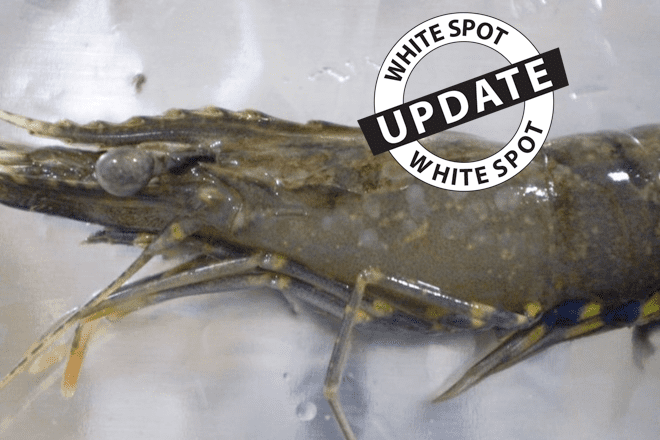Current situation
Disease control activities are continuing on the prawn farms on the Logan River, however the recent weather event associated with Tropical Cyclone Debbie delayed activities for a short time.
Surveillance for the virus that causes white spot is continuing along the east coast of Queensland. Tropical Cyclone Debbie also interrupted some surveillance activities in some locations along the east coast of Queensland.
The first round of prawn samples collected under the enhanced northern surveillance have returned negative results for the virus that causes white spot. Results for prawn samples collected from other sites are expected soon.
Movement controls
Biosecurity Queensland is issuing a reminder about the white spot movement control order and the restriction on the movement of uncooked crustaceans out of the area.
The WSD movement control area extends from Caloundra to the New South Wales border, following a line 100 metres off the eastern coasts of Bribie, Moreton and Stradbroke Islands.
Under the movement control order, prawns, crabs, yabbies and marine worms must not be removed from the movement control area unless cooked.
Queensland Boating and Fisheries Patrol will be on the water monitoring fishing activity over the Easter break.
White spot information pack
Please share the following information pack with anyone who might require additional information about white spot.
· White spot factsheet
· White spot frequently asked questions
· Guide for decontaminating fishing apparatus and vessels
· Where to find more information on white spot disease
· White spot movement control area map
· White spot movement control area poster
What is white spot disease?
WSD is a highly contagious viral disease of decapod crustaceans including prawns, crabs, yabbies and lobsters. White spot disease is caused by white spot syndrome virus (WSSV).
Where is WSD found?
WSD is widespread throughout prawn farming regions in Asia and has become established in prawns farmed in the Americas where it has caused severe losses.
How is WSD spread?
The disease is primarily spread through the movement of infected animals or water. Birds feeding on infected animals can contribute to the spread of the disease.
Can fish spread the virus?
No. Fish are not carriers of the virus that causes WSD.
How was the disease introduced to Queensland prawn farms?
At this stage it is not known how the disease was introduced to this area. Biosecurity Queensland is investigating a number of possible pathways.
What does white spot disease look like?
Prawns with WSD may have a loose shell with numerous white spots (0.5-2.0mm in diameter) on the inside surface of the shell and a pink to red discolouration.
Other signs of WSD to look for include:
- Unusual mortality
- Prawns coming to the edge or water surface
- Prawns demonstrating unusual swimming patterns.
Prawns infected with WSD can be difficult to identify. They may develop visible white spots rapidly but it is important to note that these spots are not always present and that similar spots can be caused by other factors such as bacteria, high alkalinity and stress.
While other crustaceans such as crabs can be carriers of WSD, they may not display any visible signs and must not be moved from the movement control area.
If you suspect white spot disease, you must report it to Biosecurity Queensland on 13 25 23 or the Emergency Animal Disease Watch Hotline on 1800 675 888.
What restrictions are in place?
The new movement control zone extends from Caloundra to the New South Wales (NSW) border, following a line 100 meters off the eastern coasts of Bribie, Moreton and Stradbroke Islands. It extends west to encompass the western borders of Gold Coast City Council, Brisbane City Council and Moreton Bay Regional Councils.
The use of equipment such as cast nets, crab pots and yabby pumps is allowed in the movement control area, however, anyone wishing to remove crustaceans must cook them within the movement control area which extends to high tide mark along the river. Cooking crustaceans destroys the virus that causes white spot disease so there is no risk a spreading the disease. It is important that anyone wishing to cook their catch before leaving the river, does so safely.
Further information
Further information on white spot disease is available on the Department of Agriculture and Fisheries website.
Subscribe to the Department of Agriculture and Fisheries aquatic pest and disease alerts for regular updates on the white spot disease response.
 Bush ‘n Beach Fishing Magazine Location reports & tips for fishing, boating, camping, kayaking, 4WDing in Queensland and Northern NSW
Bush ‘n Beach Fishing Magazine Location reports & tips for fishing, boating, camping, kayaking, 4WDing in Queensland and Northern NSW









